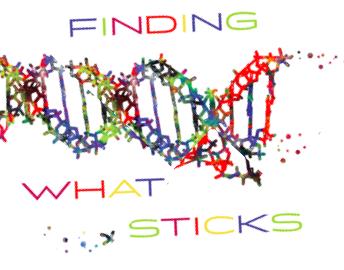
DNA keeps a diligent record of our height, eye color, affinity for sky diving and other extreme thrills, sleep habits, disease risk factors, and more. It’s no surprise then that scientists have found another job for our reliable genetic ledger: A kind of catalog for libraries of small molecules. Such libraries offer an invaluable reference for scientists working to discover new drugs to treat disease.
To understand the value in these libraries, we need to first understand how scientists discover new drugs. The exploratory trial-and-error often mimics a game of darts. Proteins function as dartboards and massive collections of small molecules act as darts. If one or more of the small molecules stick to the protein dartboard, it could indicate a relationship that deserves further exploration.
But proteins are not dartboards; they reject far more molecules than they accept. So, researchers throw millions of molecules at their protein targets hoping that just one might stick. Even then, it’s difficult to determine when that one-in-a-million event occurs. If a molecule binds to a protein, the protein might change its behavior—a clue for the scientist. But sometimes the protein remains unchanged, offering no clues. Other times, the protein–molecule duo might perform their potential therapeutic function in a cell but not a test tube.
Now, Stuart Schreiber, the Morris Loeb Professor of Chemistry and Chemical Biology, wants to improve the way scientists search for small-molecule binders. He and his team have combined two techniques: DNA-encoded libraries (DELs) and diversity-oriented synthesis (DOS). Separately, both approaches have enabled researchers to study some previously murky corners of disease biology. In tandem, they could significantly increase the chances of finding elusive starting points for drug discovery.
DEL technology combines synthetic organic chemistry with DNA barcoding to create large collections of molecules that, like books in a library, are each tagged with a specific, amplifiable code. Rather than synthesize each molecule separately and then attach its DNA-based identifier afterwards, researchers synthesize molecules and barcodes in parallel; each reaction, responsible for building a piece of the molecule, receives a small piece of DNA. When complete, the barcode reads like a reaction map, combining the codes designated to each step needed to create the molecule.
This iterative, modular approach allows researchers to construct DELs with impressive efficiency. With a technique like split–pool synthesis, the team can make masses of DNA-barcoded molecules at once. And because these libraries can grow exponentially with each subsequent step, these libraries can host billions or even trillions of molecules with minimal effort on the part of the researcher.
“It’s much more efficient compared to traditional screening technologies,” said Dr. Wenyu Wang, a postdoctoral researcher at the Broad Institute. Traditional methods use molecules without DNA barcodes, so each molecule is tested in an individual experiment to monitor which caused which effect. Such large, non-encoded libraries require specialized, expensive screening facilities. For comparison, one DEL’s trillion-molecule library can be tested simultaneously in a cheap plastic tube smaller than your thumb. “The whole technology is amazing” said Dr. Matthias Westphal, a postdoctoral researcher in the Schreiber lab. “There are so many reasons why it should not work, and yet it does.”
Still, DEL technology has a weakness. The beautiful parallel synthesis of a molecule and its barcode requires water. Most synthetic organic chemists do everything they can to exclude water from their reaction flasks, but DNA only behaves properly when wet. This constraint severely limits the types of chemical reactions that can be used to build DELs.
As a result, many libraries contain molecules with similar structures. Even exceedingly large libraries are built with only a few reactions and therefore lack structural diversity. Because structure dictates function in molecular biology, it’s likely that many of these structurally redundant molecules will bind the same proteins, leaving other potentially promising targets untouched.
The Schreiber lab has a potential solution: Diversity-oriented synthesis (DOS). True to its name, DOS can help assemble libraries of molecules with atypical molecular architectures. “Libraries that incorporate structural diversity lead to functional diversity,” explained Dr. Jeremy Mason, a postdoctoral researcher in the Schreiber lab.
Recently, drug developers have relied on these atypical molecules to design new treatments for neurodegenerative disease, malaria, and cancer, among others. But to find their molecules, most developers used a process called phenotypic screening, in which disease models are exposed to chemical treatments to discover which, if any, produce a desired effect. DOS principles have aided phenotypic screening; can they also benefit DELs?
Once again, water complicates things. To overcome the wet blanket, Westphal said the lab is “combining two approaches.” First, they select reactions that work well in water and then tweak them to make them DNA-compatible. Unfortunately, this chemical invention can take months. For quicker results, the team employs their second approach, in which they install structural complexity onto the molecule before attaching it to DNA. This up-front investment guarantees that the final DNA-barcoded molecules don’t simply replicate existing libraries.
The result of all this strategic weaving? The team has created their first library, a 107,616-member DEL with an endearingly practical name: DOS-DEL-1. Already, this achievement has inspired other researchers to design similar libraries, a DOS-DEL-2 or -3 perhaps.
“Pipetting…so much pipetting.” Dr. Liam Hudson, a postdoctoral researcher and one of the first members of the DEL team, came from a background with minimal pipetting and no exposure to DELs. In fact, despite their recent successes improving the technology, “none of the people currently doing the work in the lab has prior experience with DELs,” according to Hudson. “I like to think this means we can operate without bias towards any given way of working and focus on what we think are the key questions.”
The lack of experience could be responsible for the team’s creative approach to constructing DELs. But even the most creative ideas often benefit from a solid foundation. So to fill in any knowledge gaps, the Schreiber lab established a close collaboration with the Novartis Institutes for BioMedical Research. Schreiber is a Novartis Faculty Scholar, and team members Hudson, Mason, and Westphal work full-time in Novartis lab space. The entire cohort—including a Novartis DEL team in Basel, Switzerland—meet regularly to swap success stories, snags, and advice. “Working within the collaboration between the Schreiber lab and Novartis has been incredible,” said Mason. “We are really getting the best of both worlds.”
Moving forward, the Schreiber Lab will continue its hunt for new molecules with valuable tricks. Their first library (DOS-DEL-1) performed well with test proteins; now, the team will direct its small-molecule hordes at some of the Schreiber lab’s highest priority (and most challenging) biomolecular targets. Proteins involved in neurodegenerative diseases, such as Alzheimer’s disease and genetic prion disease, are first in line. Just one new chemical tool could lead to vital treatment for these intractable, debilitating diseases. To amplify the cause, the team hopes that other labs capitalize on the new technology to perform their own hunt for miracle molecules. “One of the advantages of DELs is that it’s easy to share libraries and perform binding experiments” noted Bruce Hua, a graduate student in the Schreiber lab. “I’m most excited by the prospect of creating a resource that many other researchers could find useful.”
In the drug discovery game of darts—with protein targets and small-molecule missiles—we forgot a crucial component: the people who play the game. Immense time, effort, and ambition help launch the hundreds of millions of molecular darts toward a potential target, with the hope that one could end up changing someone’s life for the better.
Article reprinted with permission. Originally published in CCB Magazine of the Department of Chemistry and Chemical Biology, Harvard University.



